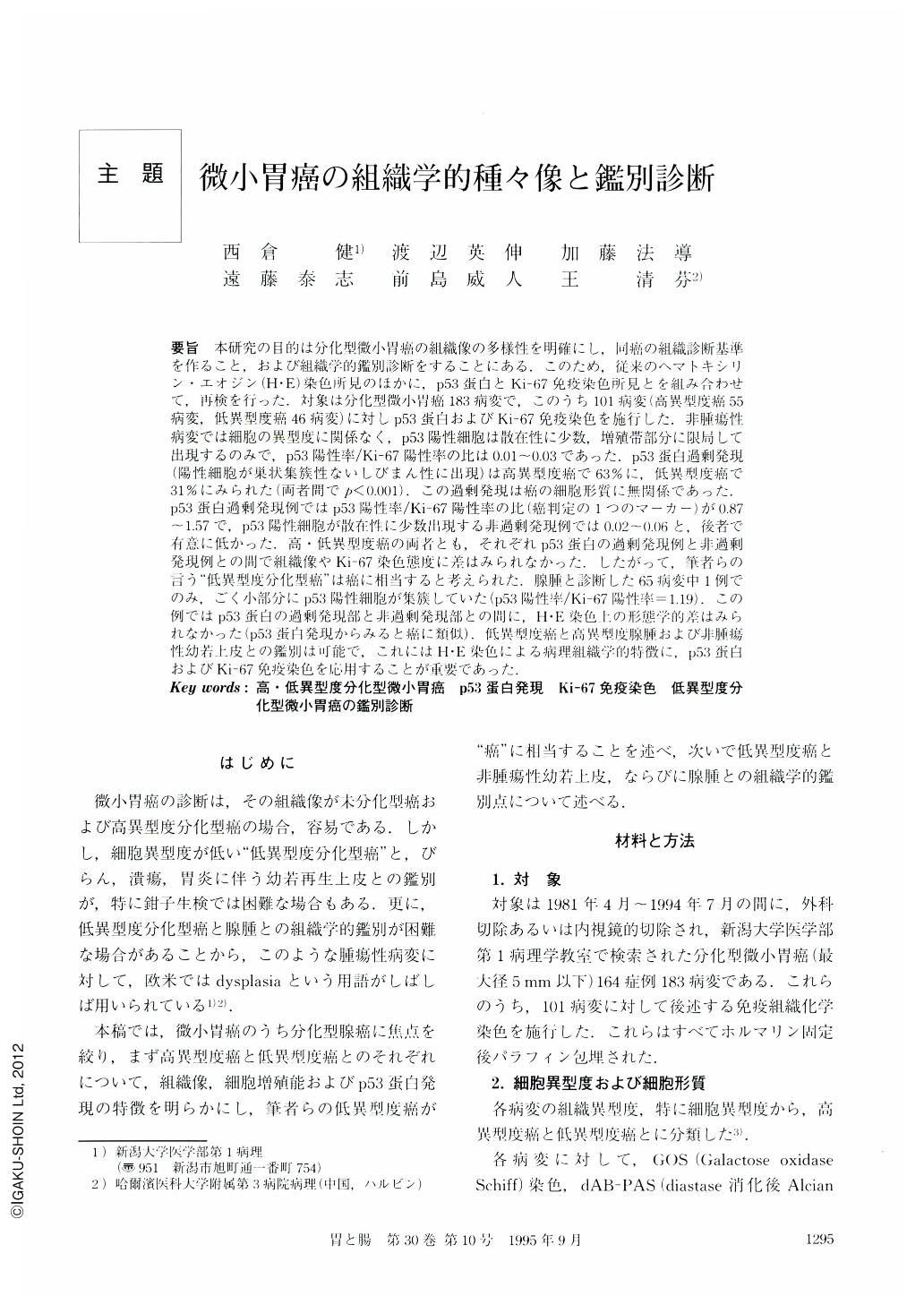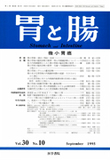Japanese
English
- 有料閲覧
- Abstract 文献概要
- 1ページ目 Look Inside
- サイト内被引用 Cited by
要旨 本研究の目的は分化型微小胃癌の組織像の多様性を明確にし,同癌の組織診断基準を作ること,および組織学的鑑別診断をすることにある.このため,従来のヘマトキシリン・エオジン(H・E)染色所見のほかに,p53蛋白とKi-67免疫染色所見とを組み合わせて,再検を行った.対象は分化型微小胃癌183病変で,このうち101病変(高異型度癌55病変,低異型度癌46病変)に対しp53蛋白およびKi-67免疫染色を施行した.非腫瘍性病変では細胞の異型度に関係なく,p53陽性細胞は散在性に少数,増殖帯部分に限局して出現するのみで,p53陽性率/Ki-67陽性率の比は0.01~0.03であった.p53蛋白過剰発現(陽性細胞が巣状集簇性ないしびまん性に出現)は高異型度癌で63%に,低異型度癌で31%にみられた(両者間でp<0.001).この過剰発現は癌の細胞形質に無関係であった.p53蛋白過剰発現例ではp53陽性率/Ki-67陽性率の比(癌判定の1つのマーカー)が0.87~1.57で,p53陽性細胞が散在性に少数出現する非過剰発現例では0.02~0.06と,後者で有意に低かった.高・低異型度癌の両者とも,それぞれp53蛋白の過剰発現例と非過剰発現例との間で組織像やKi-67染色態度に差はみられなかった.したがって,筆者らの言う“低異型度分化型癌”は癌に相当すると考えられた.腺腫と診断した65病変中1例でのみ,ごく小部分にp53陽性細胞が集簇していた(p53陽性率/Ki-67陽性率=1.19).この例ではp53蛋白の過剰発現部と非過剰発現部との問に,H・E染色上の形態学的差はみられなかった(p53蛋白発現からみると癌に類似).低異型度癌と高異型度腺腫および非腫瘍性幼若上皮との鑑別は可能で,これにはH・E染色による病理組織学的特徴に,p53蛋白およびKi-67免疫染色を応用することが重要であった.
The aims of this study were to elucidate histological varieties of gastric microcarcinoma of differentiated type and its differential diagnosis. For these purposes we used p53 and Ki-67 immunostaining as well as conventional hematoxylin-eosin (H・E) staining, because overexpression (focally aggregated or diffuse positivity) of p53 immunoreactive cells is believed to be a useful marker for a diagnosis of carcinoma. The test subjects were 101 differentiated gastric microcarcinomas, which were divided cytologically into high-grade carcinoma (55 tumors) and low-grade carcinoma (46 tumors), according to our definition reported previously.
p53 reactive cell (one or a few) in non-neoplastic mucosa was limited within the proliferative zone and detected in 0.8% (10/1,253) of proper gastric tubules, and in 1.3% (27/2,096) of intestinalized tubules. The rate of p53 index to Ki-67 index in the proliferative zone of a corresponding area was 0.02 in both the former and the later. p53 overexpression was detected in 63% of high-grade and 31% of low-grade microcarcinoma (p<0.001). Its overexpression had no correlation with cell-phenotype of microcarcinoma. The p53/Ki-67 rate of microcarcinomas was 0.87 to 1.57 in overexpression cases, and 0.02 to 0.06 in sporadic p53 expression cases of both high- and low-grade tumors. There were no differences in histological findings or Ki-67 immunostaining pattern between the p53 overexpression and non-overexpression microcarcinomas. These results suggest that low-grade microcarcinoma actually are carcinoma.
The number of tubules and cells with p53 reactivity increased in mucosa with immature regenerative epithe-lium, but p53 positive cells were few in number and confined within a widened proliferative zone, and p53/Ki-67 rate was 0.01 to 0.03. Out of 65 gastric adenomas, p53 immunoreactivity was negative in 29, sporadic in 35 and focally aggregated in one tumor. The focally aggregated area indicated a 65.0 p53 positive cell index and 1.19 p53/Ki-67 rate, but the remaining area of the same tumor indicated only a 1.1% p53 positive cell index and 0.02 p53/Ki-67 rate. In this case, there was no histological difference between p53 overexpression and non-overexpressed area. Combination of conventional H・E findings with p53 and Ki-67 immunostaining is a good method to distinguish differentiated-type microcarcinoma of low-grade atypia from adenoma or non-neoplastic immature epithelium.

Copyright © 1995, Igaku-Shoin Ltd. All rights reserved.


